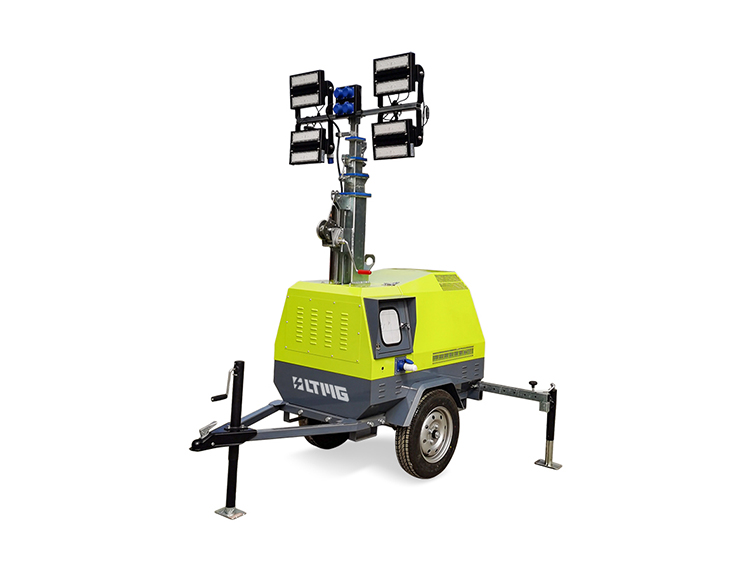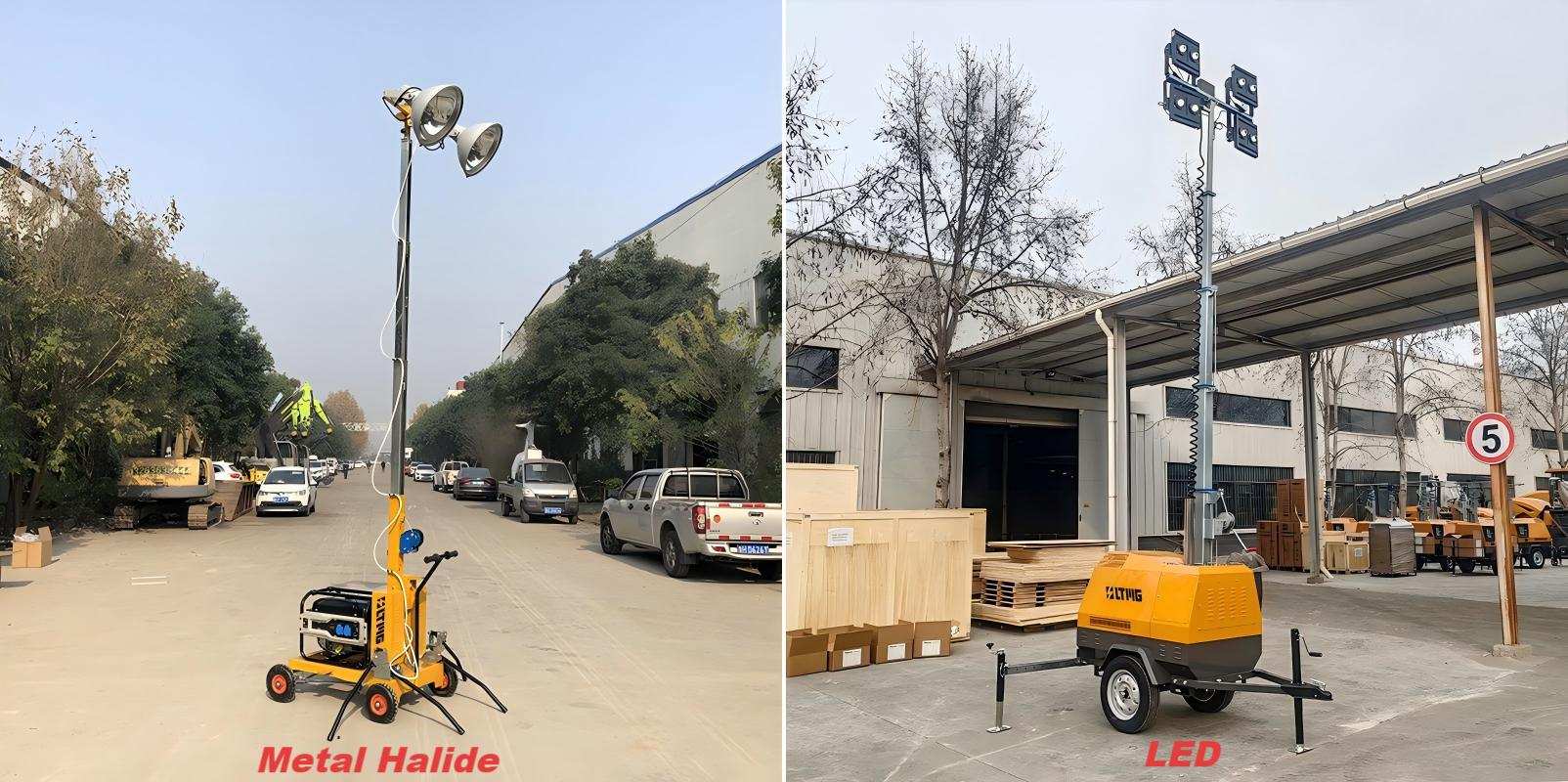Introducción: Cuando cae la noche, la luz es la primera garantía de seguridad y eficiencia
Según nuestra experiencia, los métodos tradicionales de iluminación temporal, como la instalación de postes fijos dispersos o el uso de pequeños generadores con cables, presentan numerosos inconvenientes. No solo son lentos de instalar y requieren electricistas profesionales, sino que también suelen generar puntos ciegos, iluminación irregular y deslumbramiento intenso. Y lo que es más importante, la tecnología obsoleta de halogenuros metálicos conlleva un consumo de combustible extremadamente alto y frecuentes fallos en los equipos, lo que añade importantes costes ocultos al proyecto.
Precisamente por eso se desarrolló la torre de iluminación móvil (Lighting Tower). Se trata de un dispositivo de iluminación motorizado que integra un generador de alto rendimiento, un mástil de elevación automático y lámparas de alta eficiencia, aclamado como el "sol móvil" para obras y situaciones de emergencia.
En este artículo, aprovechando nuestra experiencia acumulada en el campo de las soluciones de iluminación, profundizaremos en el núcleo técnico de las torres de iluminación.
 Inmersión profunda: cómo Torres de iluminación Convierte la oscuridad en luz
Inmersión profunda: cómo Torres de iluminación Convierte la oscuridad en luz
Para comprender verdaderamente el valor de una torre de iluminación, primero debemos comprender su estructura interna y sus principios de funcionamiento. Esto refleja el fabricante y la industria.
Desglose de los componentes principales (Anatomía de una torre de iluminación)
Una torre de iluminación moderna es un producto de ingeniería de precisión, compuesta principalmente de cuatro partes:
1. El sistema de iluminación (las luces). Esta es la parte más visible de la torre de iluminación. La opción predominante en el mercado actual ha pasado de los halogenuros metálicos a los LED.
LED vs. Haluro metálico: Esta es una división tecnológica crítica.

2. El mástil telescópico (El Mástil) El mástil determina la altura y el área de cobertura de la iluminación.
3. El núcleo de potencia (la fuente de energía) Es el corazón de la torre de iluminación y determina su tiempo de funcionamiento y los escenarios de aplicación para construcción o uso de emergencia.
4. Sistema de control y movilidad
Más que solo luz: las cinco ventajas principales de las torres de iluminación
Con base en los detalles anteriores, las torres de iluminación ofrecen a los usuarios cinco valores fundamentales que van más allá de la mera iluminación, destacando su presencia en la industria.
1. Máxima movilidad y respuesta rápida: Ya sea montada en un remolque o en un vehículo, una torre de iluminación puede desplegarse y su mástil elevarse en minutos. Esta rápida capacidad de respuesta es crucial para la rapidez en la respuesta a emergencias y la flexibilidad de las obras.
2. Rendimiento de iluminación superior y seguridad: Los cabezales de luz LED de alto rendimiento pueden proporcionar decenas o incluso cientos de miles de lúmenes. Combinados con un mástil giratorio de 360°, ofrecen una iluminación uniforme y sin sombras en miles de metros cuadrados. Una distribución de iluminación profesional elimina los puntos ciegos y reduce significativamente los accidentes en el trabajo nocturno.
3. Ahorros significativos en costos operativos (TCO): Este es un punto que a menudo se pasa por alto. Si bien el precio inicial de compra de los modelos LED o híbridos puede ser mayor, el ahorro es asombroso:
4. Diseño robusto, resistente a la intemperie y duradero: Las torres de iluminación profesionales están diseñadas para los entornos más exigentes. Esto se refleja en los detalles de diseño:
5. Automático inteligente y ecológico: Los controles con sensor de luz (operación desde el anochecer hasta el amanecer) reducen la intervención manual innecesaria y el desperdicio de energía. Además, las tecnologías eléctricas, solares e híbridas ayudan a las empresas a reducir su huella de carbono, cumpliendo con los estándares ESG (ambientales, sociales y de gobernanza) de ingeniería moderna.
Pruebas en el mundo real: El mapa de aplicaciones de las torres de iluminación
Hablar de tecnología es mucho menos efectivo que demostrar experiencia práctica. El valor de las torres de iluminación móviles se ha demostrado en diversos sitios exigentes a nivel mundial, lo que constituye la mejor prueba de su fiabilidad.
Áreas de aplicación principales:
Guía de compra experta: Cómo elegir la torre de iluminación adecuada
Como industria, esta guía que ofrecemos tiene como objetivo ayudarlo a generar confianza y evitar errores de compra comunes.
5 preguntas para aclarar antes de comprar
Antes de contactar con un proveedor, aclare sus necesidades:
1. Necesidad: ¿Qué área más grande necesitas iluminar?
Un lugar de reparación de 500 metros cuadrados y un sitio de construcción de 5000 metros cuadrados tienen requisitos muy diferentes en cuanto a lúmenes totales, cantidad de luminarias y altura del mástil.
2. Energía: ¿Cómo es su entorno operativo?
¿Hay acceso a la red eléctrica? ¿Está cerca de áreas residenciales u hospitales (que requieren baterías silenciosas o modelos híbridos)? ¿Necesita una operación fija a largo plazo en un lugar (un modelo alimentado con energía solar puede ser la mejor opción)?
3. Movilidad: ¿Con qué frecuencia te mudarás?
Para mudanzas ocasionales dentro de una obra grande, basta con un chasis todoterreno resistente. Para traslados frecuentes entre ciudades, debe elegir un remolque estándar con sistema de dirección y frenos.
4. Presupuesto: ¿Sólo te fijas en el precio de compra?
Aquí tienes un consejo profesional: Una trampa común es centrarse únicamente en el precio de compra inicial e ignorar el coste total de propiedad (TCO). Si bien las torres de iluminación LED e híbridas de bajo consumo tienen un coste inicial ligeramente superior, suelen amortizar la diferencia en ahorro de combustible en un plazo de 6 a 12 meses.
5. Medio ambiente: ¿Qué tan duras son las condiciones climáticas?
Conclusión: Ilumina tu próximo proyecto exitoso
En las operaciones nocturnas modernas, la electrificación y la automatización están convirtiendo la torre de iluminación móvil de una "opción" en una "necesidad".
Desde la reducción de riesgos de seguridad en los sitios de construcción hasta el aumento de la eficiencia durante la respuesta a emergencias y el cumplimiento de los estándares de construcción ecológica, una torre de iluminación móvil de alta calidad está redefiniendo la seguridad y la eficiencia del trabajo nocturno.
Aprovechando un profundo servicio técnico y de proyectos globales, los proveedores de soluciones de iluminación profesional se comprometen a ofrecerle las garantías de iluminación más sólidas, inteligentes y eficientes.
📮Correo electrónico: market@ltmg.com
📞WhatsApp/Wechat: +86 19559207570